Dubai: Where Small is Beautiful - A Study on Luxury Consumption
VerifiedAdded on 2019/09/22
|9
|2483
|175
Report
AI Summary
The provided content consists of various academic articles and papers that discuss Dubai as a destination for tourism and luxury consumption. The topics covered include the city's prestige urban projects, its luxury hotel industry, and its emerging reputation as a shopping tourism destination. The authors also explore the perceptions of young tourists from the United Arab Emirates (UAE) and examine the strategic branding efforts of Dubai as a tourist destination. Additionally, some papers delve into the themes of sustainable tourism, customer satisfaction strategies in multi-cultural environments, and the semiotics of luxury and privilege.
Contribute Materials
Your contribution can guide someone’s learning journey. Share your
documents today.
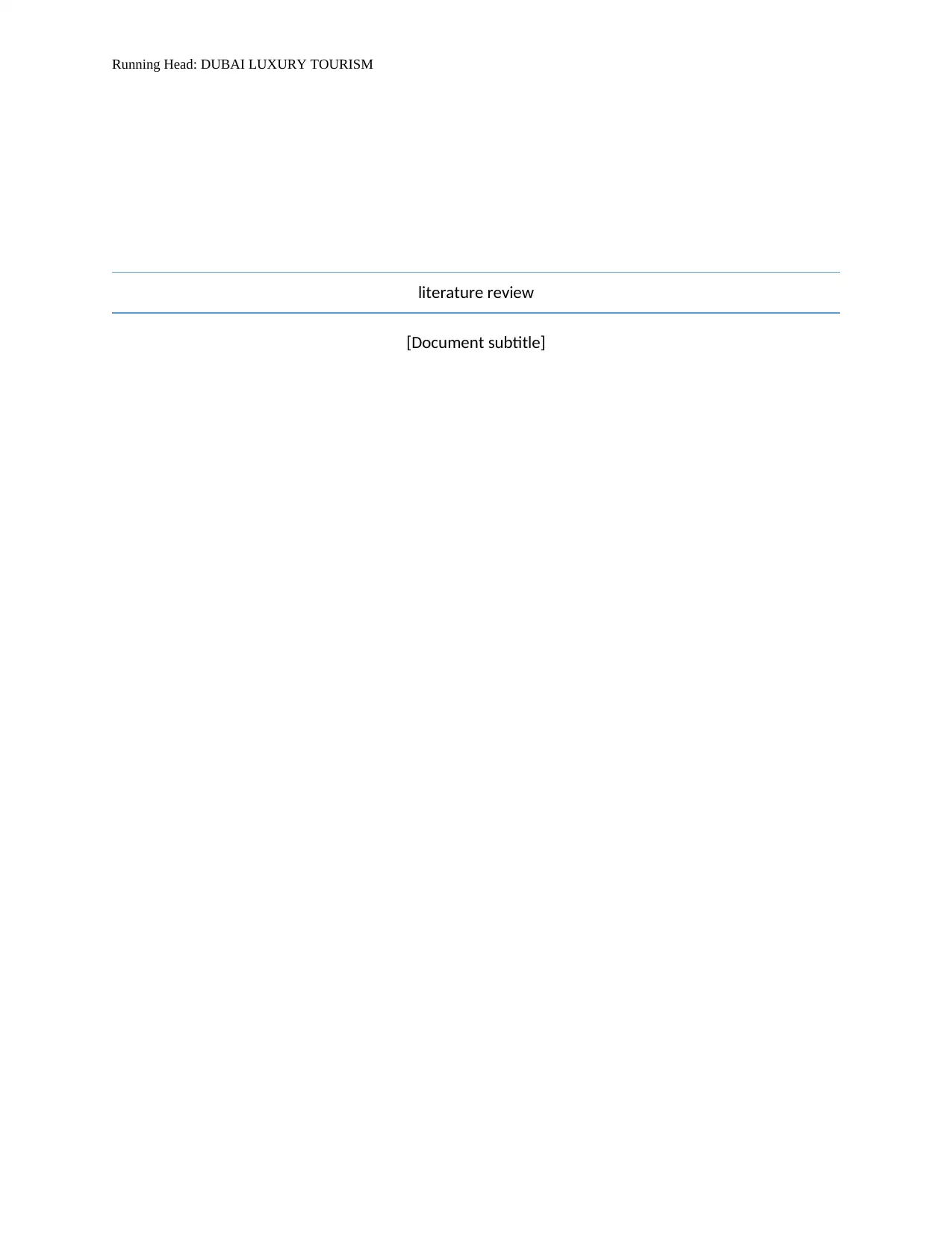
Running Head: DUBAI LUXURY TOURISM
literature review
[Document subtitle]
literature review
[Document subtitle]
Secure Best Marks with AI Grader
Need help grading? Try our AI Grader for instant feedback on your assignments.
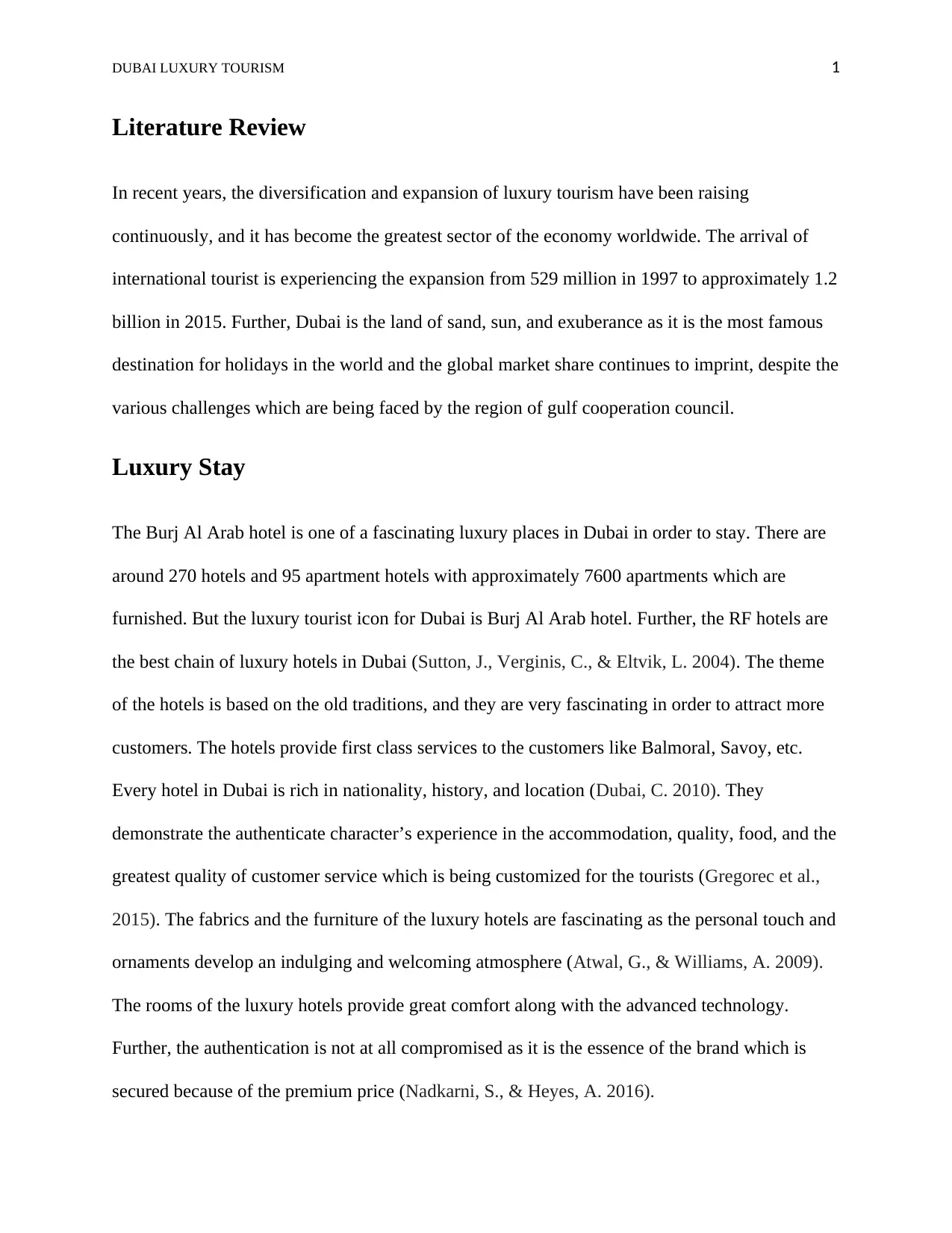
DUBAI LUXURY TOURISM 1
Literature Review
In recent years, the diversification and expansion of luxury tourism have been raising
continuously, and it has become the greatest sector of the economy worldwide. The arrival of
international tourist is experiencing the expansion from 529 million in 1997 to approximately 1.2
billion in 2015. Further, Dubai is the land of sand, sun, and exuberance as it is the most famous
destination for holidays in the world and the global market share continues to imprint, despite the
various challenges which are being faced by the region of gulf cooperation council.
Luxury Stay
The Burj Al Arab hotel is one of a fascinating luxury places in Dubai in order to stay. There are
around 270 hotels and 95 apartment hotels with approximately 7600 apartments which are
furnished. But the luxury tourist icon for Dubai is Burj Al Arab hotel. Further, the RF hotels are
the best chain of luxury hotels in Dubai (Sutton, J., Verginis, C., & Eltvik, L. 2004). The theme
of the hotels is based on the old traditions, and they are very fascinating in order to attract more
customers. The hotels provide first class services to the customers like Balmoral, Savoy, etc.
Every hotel in Dubai is rich in nationality, history, and location (Dubai, C. 2010). They
demonstrate the authenticate character’s experience in the accommodation, quality, food, and the
greatest quality of customer service which is being customized for the tourists (Gregorec et al.,
2015). The fabrics and the furniture of the luxury hotels are fascinating as the personal touch and
ornaments develop an indulging and welcoming atmosphere (Atwal, G., & Williams, A. 2009).
The rooms of the luxury hotels provide great comfort along with the advanced technology.
Further, the authentication is not at all compromised as it is the essence of the brand which is
secured because of the premium price (Nadkarni, S., & Heyes, A. 2016).
Literature Review
In recent years, the diversification and expansion of luxury tourism have been raising
continuously, and it has become the greatest sector of the economy worldwide. The arrival of
international tourist is experiencing the expansion from 529 million in 1997 to approximately 1.2
billion in 2015. Further, Dubai is the land of sand, sun, and exuberance as it is the most famous
destination for holidays in the world and the global market share continues to imprint, despite the
various challenges which are being faced by the region of gulf cooperation council.
Luxury Stay
The Burj Al Arab hotel is one of a fascinating luxury places in Dubai in order to stay. There are
around 270 hotels and 95 apartment hotels with approximately 7600 apartments which are
furnished. But the luxury tourist icon for Dubai is Burj Al Arab hotel. Further, the RF hotels are
the best chain of luxury hotels in Dubai (Sutton, J., Verginis, C., & Eltvik, L. 2004). The theme
of the hotels is based on the old traditions, and they are very fascinating in order to attract more
customers. The hotels provide first class services to the customers like Balmoral, Savoy, etc.
Every hotel in Dubai is rich in nationality, history, and location (Dubai, C. 2010). They
demonstrate the authenticate character’s experience in the accommodation, quality, food, and the
greatest quality of customer service which is being customized for the tourists (Gregorec et al.,
2015). The fabrics and the furniture of the luxury hotels are fascinating as the personal touch and
ornaments develop an indulging and welcoming atmosphere (Atwal, G., & Williams, A. 2009).
The rooms of the luxury hotels provide great comfort along with the advanced technology.
Further, the authentication is not at all compromised as it is the essence of the brand which is
secured because of the premium price (Nadkarni, S., & Heyes, A. 2016).
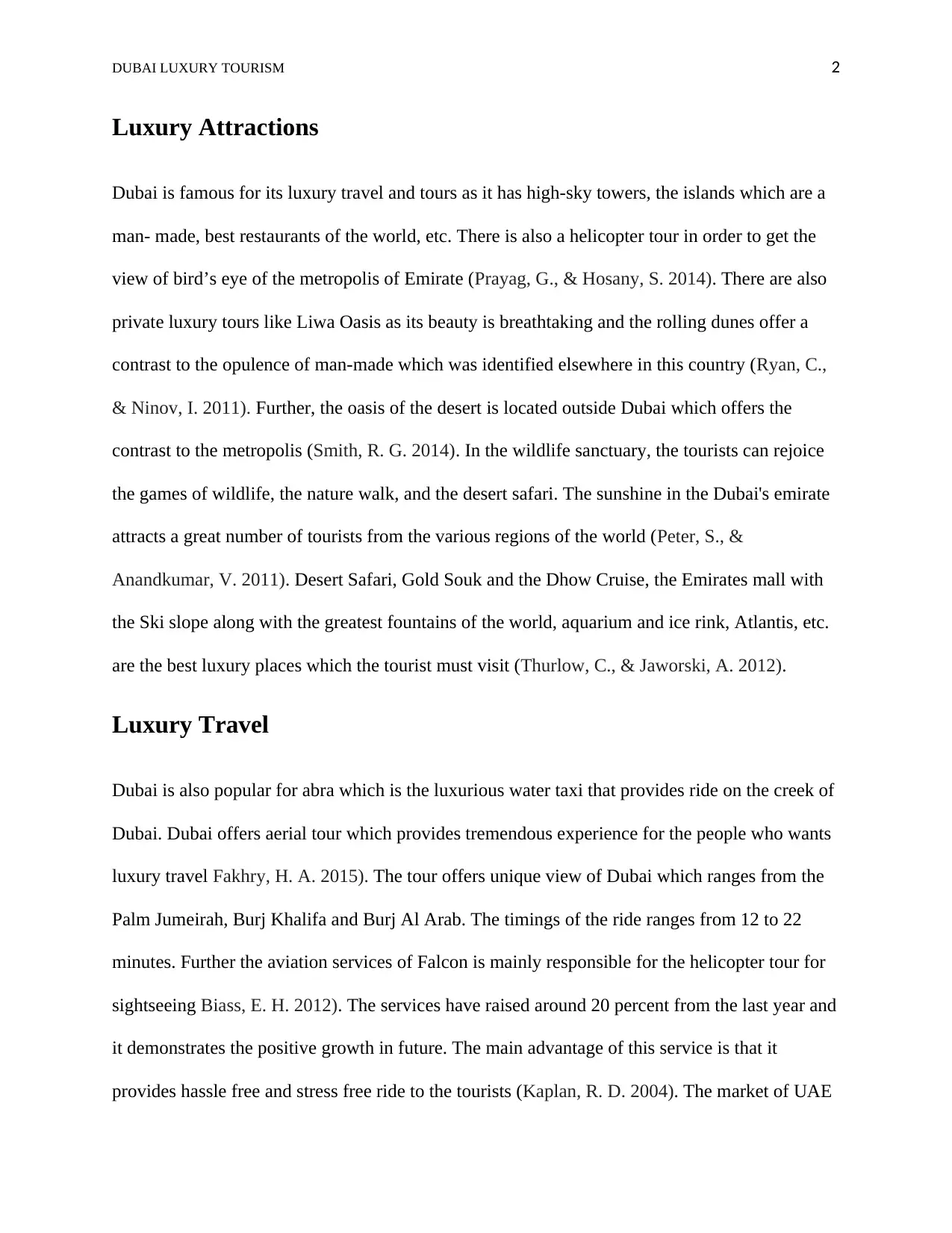
DUBAI LUXURY TOURISM 2
Luxury Attractions
Dubai is famous for its luxury travel and tours as it has high-sky towers, the islands which are a
man- made, best restaurants of the world, etc. There is also a helicopter tour in order to get the
view of bird’s eye of the metropolis of Emirate (Prayag, G., & Hosany, S. 2014). There are also
private luxury tours like Liwa Oasis as its beauty is breathtaking and the rolling dunes offer a
contrast to the opulence of man-made which was identified elsewhere in this country (Ryan, C.,
& Ninov, I. 2011). Further, the oasis of the desert is located outside Dubai which offers the
contrast to the metropolis (Smith, R. G. 2014). In the wildlife sanctuary, the tourists can rejoice
the games of wildlife, the nature walk, and the desert safari. The sunshine in the Dubai's emirate
attracts a great number of tourists from the various regions of the world (Peter, S., &
Anandkumar, V. 2011). Desert Safari, Gold Souk and the Dhow Cruise, the Emirates mall with
the Ski slope along with the greatest fountains of the world, aquarium and ice rink, Atlantis, etc.
are the best luxury places which the tourist must visit (Thurlow, C., & Jaworski, A. 2012).
Luxury Travel
Dubai is also popular for abra which is the luxurious water taxi that provides ride on the creek of
Dubai. Dubai offers aerial tour which provides tremendous experience for the people who wants
luxury travel Fakhry, H. A. 2015). The tour offers unique view of Dubai which ranges from the
Palm Jumeirah, Burj Khalifa and Burj Al Arab. The timings of the ride ranges from 12 to 22
minutes. Further the aviation services of Falcon is mainly responsible for the helicopter tour for
sightseeing Biass, E. H. 2012). The services have raised around 20 percent from the last year and
it demonstrates the positive growth in future. The main advantage of this service is that it
provides hassle free and stress free ride to the tourists (Kaplan, R. D. 2004). The market of UAE
Luxury Attractions
Dubai is famous for its luxury travel and tours as it has high-sky towers, the islands which are a
man- made, best restaurants of the world, etc. There is also a helicopter tour in order to get the
view of bird’s eye of the metropolis of Emirate (Prayag, G., & Hosany, S. 2014). There are also
private luxury tours like Liwa Oasis as its beauty is breathtaking and the rolling dunes offer a
contrast to the opulence of man-made which was identified elsewhere in this country (Ryan, C.,
& Ninov, I. 2011). Further, the oasis of the desert is located outside Dubai which offers the
contrast to the metropolis (Smith, R. G. 2014). In the wildlife sanctuary, the tourists can rejoice
the games of wildlife, the nature walk, and the desert safari. The sunshine in the Dubai's emirate
attracts a great number of tourists from the various regions of the world (Peter, S., &
Anandkumar, V. 2011). Desert Safari, Gold Souk and the Dhow Cruise, the Emirates mall with
the Ski slope along with the greatest fountains of the world, aquarium and ice rink, Atlantis, etc.
are the best luxury places which the tourist must visit (Thurlow, C., & Jaworski, A. 2012).
Luxury Travel
Dubai is also popular for abra which is the luxurious water taxi that provides ride on the creek of
Dubai. Dubai offers aerial tour which provides tremendous experience for the people who wants
luxury travel Fakhry, H. A. 2015). The tour offers unique view of Dubai which ranges from the
Palm Jumeirah, Burj Khalifa and Burj Al Arab. The timings of the ride ranges from 12 to 22
minutes. Further the aviation services of Falcon is mainly responsible for the helicopter tour for
sightseeing Biass, E. H. 2012). The services have raised around 20 percent from the last year and
it demonstrates the positive growth in future. The main advantage of this service is that it
provides hassle free and stress free ride to the tourists (Kaplan, R. D. 2004). The market of UAE
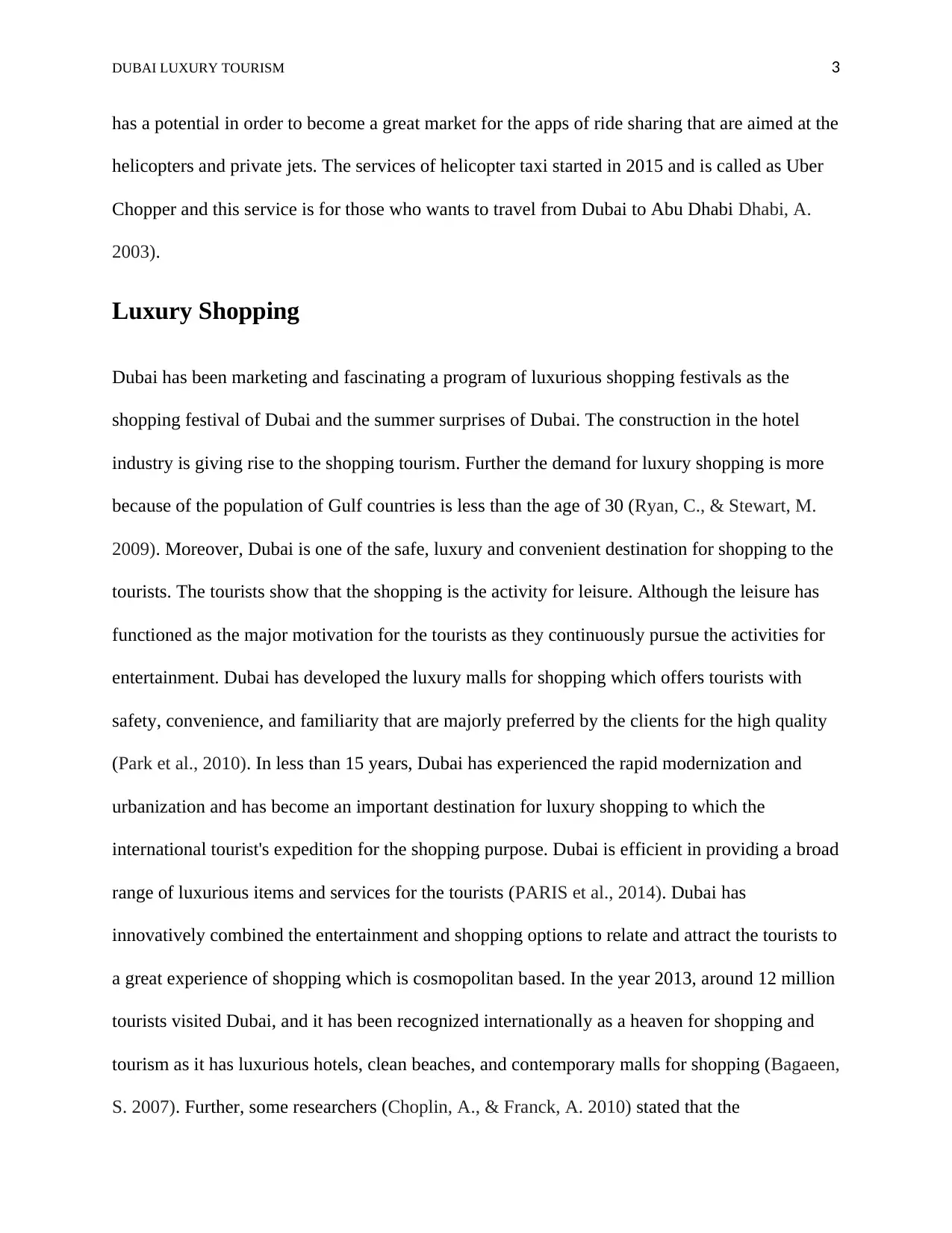
DUBAI LUXURY TOURISM 3
has a potential in order to become a great market for the apps of ride sharing that are aimed at the
helicopters and private jets. The services of helicopter taxi started in 2015 and is called as Uber
Chopper and this service is for those who wants to travel from Dubai to Abu Dhabi Dhabi, A.
2003).
Luxury Shopping
Dubai has been marketing and fascinating a program of luxurious shopping festivals as the
shopping festival of Dubai and the summer surprises of Dubai. The construction in the hotel
industry is giving rise to the shopping tourism. Further the demand for luxury shopping is more
because of the population of Gulf countries is less than the age of 30 (Ryan, C., & Stewart, M.
2009). Moreover, Dubai is one of the safe, luxury and convenient destination for shopping to the
tourists. The tourists show that the shopping is the activity for leisure. Although the leisure has
functioned as the major motivation for the tourists as they continuously pursue the activities for
entertainment. Dubai has developed the luxury malls for shopping which offers tourists with
safety, convenience, and familiarity that are majorly preferred by the clients for the high quality
(Park et al., 2010). In less than 15 years, Dubai has experienced the rapid modernization and
urbanization and has become an important destination for luxury shopping to which the
international tourist's expedition for the shopping purpose. Dubai is efficient in providing a broad
range of luxurious items and services for the tourists (PARIS et al., 2014). Dubai has
innovatively combined the entertainment and shopping options to relate and attract the tourists to
a great experience of shopping which is cosmopolitan based. In the year 2013, around 12 million
tourists visited Dubai, and it has been recognized internationally as a heaven for shopping and
tourism as it has luxurious hotels, clean beaches, and contemporary malls for shopping (Bagaeen,
S. 2007). Further, some researchers (Choplin, A., & Franck, A. 2010) stated that the
has a potential in order to become a great market for the apps of ride sharing that are aimed at the
helicopters and private jets. The services of helicopter taxi started in 2015 and is called as Uber
Chopper and this service is for those who wants to travel from Dubai to Abu Dhabi Dhabi, A.
2003).
Luxury Shopping
Dubai has been marketing and fascinating a program of luxurious shopping festivals as the
shopping festival of Dubai and the summer surprises of Dubai. The construction in the hotel
industry is giving rise to the shopping tourism. Further the demand for luxury shopping is more
because of the population of Gulf countries is less than the age of 30 (Ryan, C., & Stewart, M.
2009). Moreover, Dubai is one of the safe, luxury and convenient destination for shopping to the
tourists. The tourists show that the shopping is the activity for leisure. Although the leisure has
functioned as the major motivation for the tourists as they continuously pursue the activities for
entertainment. Dubai has developed the luxury malls for shopping which offers tourists with
safety, convenience, and familiarity that are majorly preferred by the clients for the high quality
(Park et al., 2010). In less than 15 years, Dubai has experienced the rapid modernization and
urbanization and has become an important destination for luxury shopping to which the
international tourist's expedition for the shopping purpose. Dubai is efficient in providing a broad
range of luxurious items and services for the tourists (PARIS et al., 2014). Dubai has
innovatively combined the entertainment and shopping options to relate and attract the tourists to
a great experience of shopping which is cosmopolitan based. In the year 2013, around 12 million
tourists visited Dubai, and it has been recognized internationally as a heaven for shopping and
tourism as it has luxurious hotels, clean beaches, and contemporary malls for shopping (Bagaeen,
S. 2007). Further, some researchers (Choplin, A., & Franck, A. 2010) stated that the
Secure Best Marks with AI Grader
Need help grading? Try our AI Grader for instant feedback on your assignments.
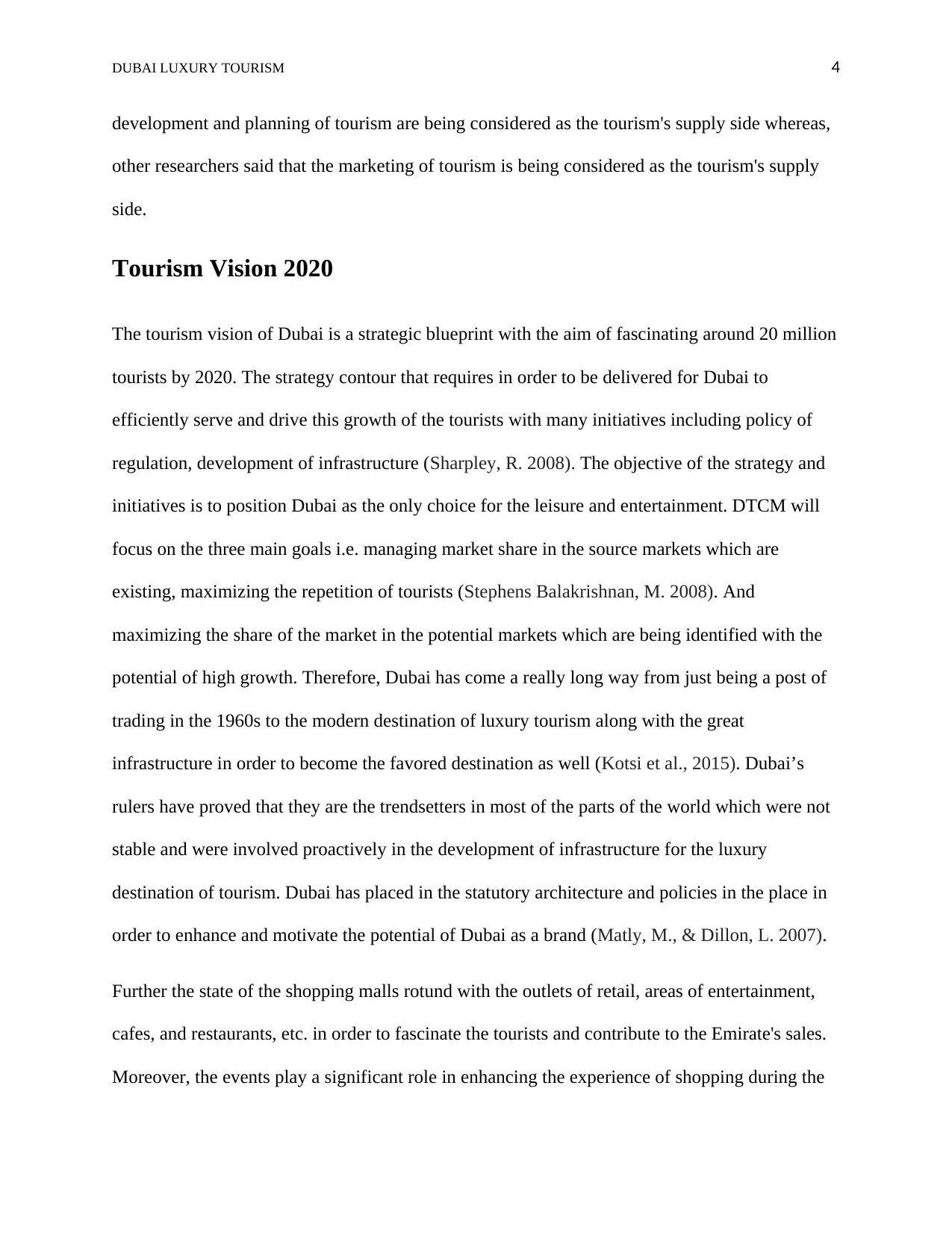
DUBAI LUXURY TOURISM 4
development and planning of tourism are being considered as the tourism's supply side whereas,
other researchers said that the marketing of tourism is being considered as the tourism's supply
side.
Tourism Vision 2020
The tourism vision of Dubai is a strategic blueprint with the aim of fascinating around 20 million
tourists by 2020. The strategy contour that requires in order to be delivered for Dubai to
efficiently serve and drive this growth of the tourists with many initiatives including policy of
regulation, development of infrastructure (Sharpley, R. 2008). The objective of the strategy and
initiatives is to position Dubai as the only choice for the leisure and entertainment. DTCM will
focus on the three main goals i.e. managing market share in the source markets which are
existing, maximizing the repetition of tourists (Stephens Balakrishnan, M. 2008). And
maximizing the share of the market in the potential markets which are being identified with the
potential of high growth. Therefore, Dubai has come a really long way from just being a post of
trading in the 1960s to the modern destination of luxury tourism along with the great
infrastructure in order to become the favored destination as well (Kotsi et al., 2015). Dubai’s
rulers have proved that they are the trendsetters in most of the parts of the world which were not
stable and were involved proactively in the development of infrastructure for the luxury
destination of tourism. Dubai has placed in the statutory architecture and policies in the place in
order to enhance and motivate the potential of Dubai as a brand (Matly, M., & Dillon, L. 2007).
Further the state of the shopping malls rotund with the outlets of retail, areas of entertainment,
cafes, and restaurants, etc. in order to fascinate the tourists and contribute to the Emirate's sales.
Moreover, the events play a significant role in enhancing the experience of shopping during the
development and planning of tourism are being considered as the tourism's supply side whereas,
other researchers said that the marketing of tourism is being considered as the tourism's supply
side.
Tourism Vision 2020
The tourism vision of Dubai is a strategic blueprint with the aim of fascinating around 20 million
tourists by 2020. The strategy contour that requires in order to be delivered for Dubai to
efficiently serve and drive this growth of the tourists with many initiatives including policy of
regulation, development of infrastructure (Sharpley, R. 2008). The objective of the strategy and
initiatives is to position Dubai as the only choice for the leisure and entertainment. DTCM will
focus on the three main goals i.e. managing market share in the source markets which are
existing, maximizing the repetition of tourists (Stephens Balakrishnan, M. 2008). And
maximizing the share of the market in the potential markets which are being identified with the
potential of high growth. Therefore, Dubai has come a really long way from just being a post of
trading in the 1960s to the modern destination of luxury tourism along with the great
infrastructure in order to become the favored destination as well (Kotsi et al., 2015). Dubai’s
rulers have proved that they are the trendsetters in most of the parts of the world which were not
stable and were involved proactively in the development of infrastructure for the luxury
destination of tourism. Dubai has placed in the statutory architecture and policies in the place in
order to enhance and motivate the potential of Dubai as a brand (Matly, M., & Dillon, L. 2007).
Further the state of the shopping malls rotund with the outlets of retail, areas of entertainment,
cafes, and restaurants, etc. in order to fascinate the tourists and contribute to the Emirate's sales.
Moreover, the events play a significant role in enhancing the experience of shopping during the
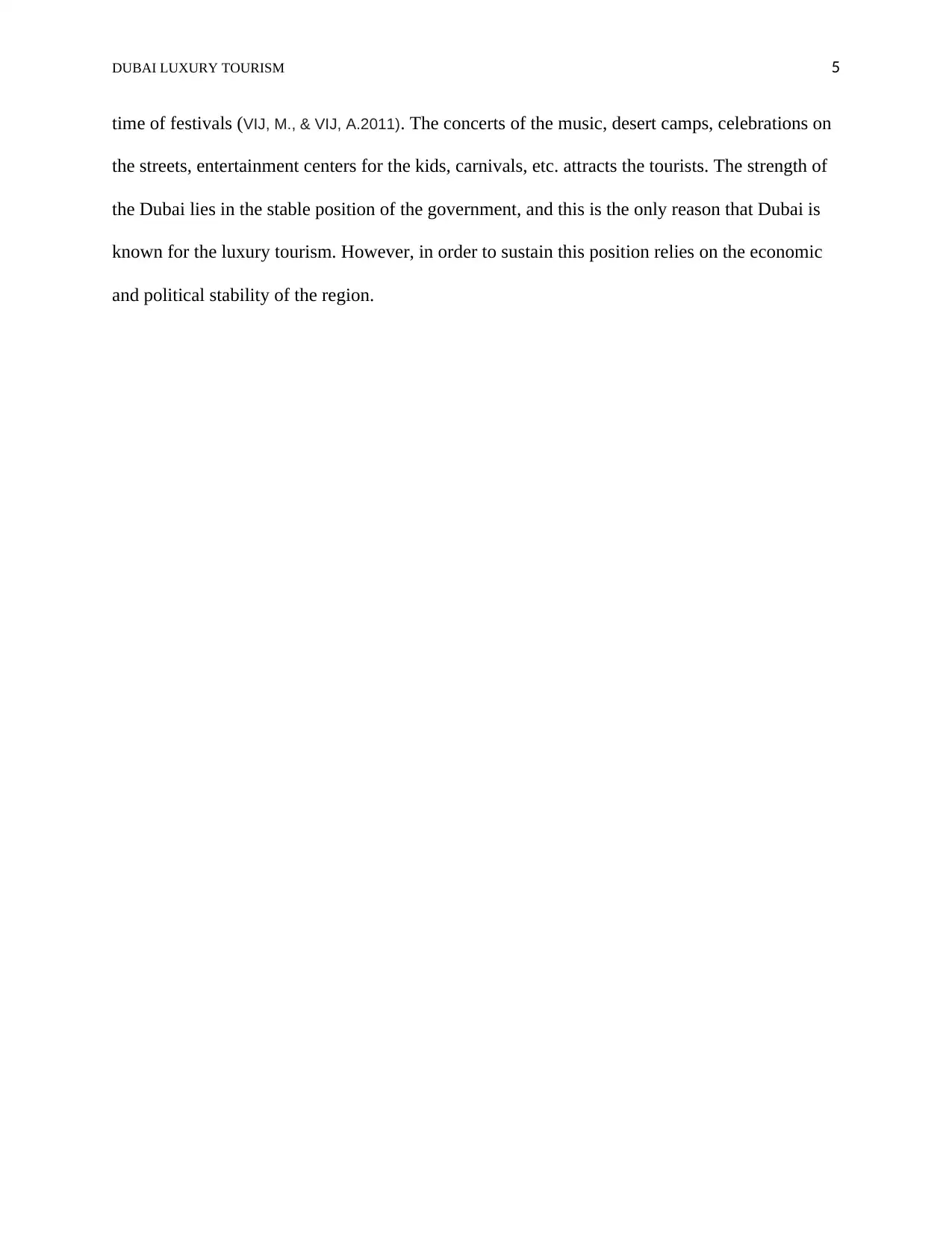
DUBAI LUXURY TOURISM 5
time of festivals (VIJ, M., & VIJ, A.2011). The concerts of the music, desert camps, celebrations on
the streets, entertainment centers for the kids, carnivals, etc. attracts the tourists. The strength of
the Dubai lies in the stable position of the government, and this is the only reason that Dubai is
known for the luxury tourism. However, in order to sustain this position relies on the economic
and political stability of the region.
time of festivals (VIJ, M., & VIJ, A.2011). The concerts of the music, desert camps, celebrations on
the streets, entertainment centers for the kids, carnivals, etc. attracts the tourists. The strength of
the Dubai lies in the stable position of the government, and this is the only reason that Dubai is
known for the luxury tourism. However, in order to sustain this position relies on the economic
and political stability of the region.
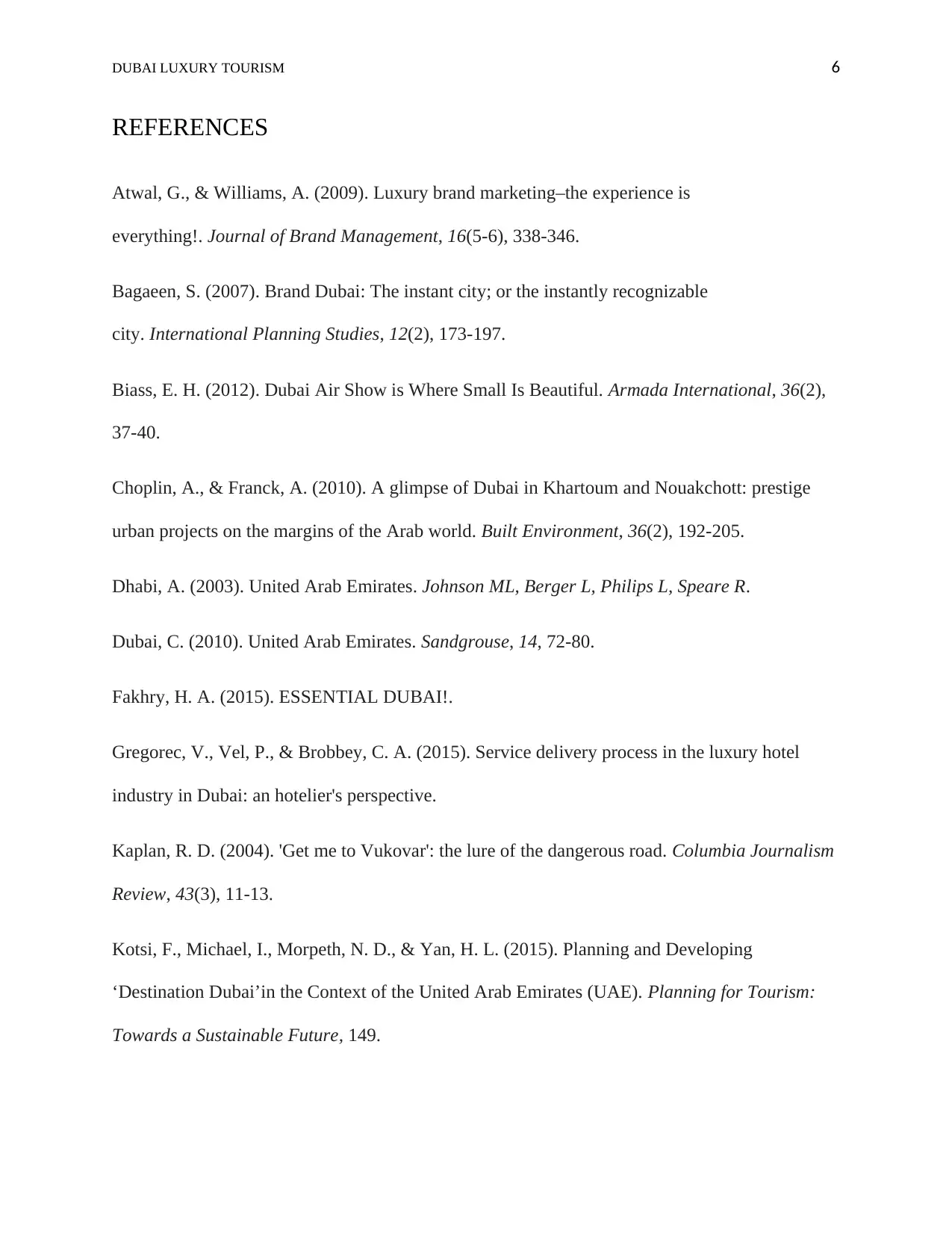
DUBAI LUXURY TOURISM 6
REFERENCES
Atwal, G., & Williams, A. (2009). Luxury brand marketing–the experience is
everything!. Journal of Brand Management, 16(5-6), 338-346.
Bagaeen, S. (2007). Brand Dubai: The instant city; or the instantly recognizable
city. International Planning Studies, 12(2), 173-197.
Biass, E. H. (2012). Dubai Air Show is Where Small Is Beautiful. Armada International, 36(2),
37-40.
Choplin, A., & Franck, A. (2010). A glimpse of Dubai in Khartoum and Nouakchott: prestige
urban projects on the margins of the Arab world. Built Environment, 36(2), 192-205.
Dhabi, A. (2003). United Arab Emirates. Johnson ML, Berger L, Philips L, Speare R.
Dubai, C. (2010). United Arab Emirates. Sandgrouse, 14, 72-80.
Fakhry, H. A. (2015). ESSENTIAL DUBAI!.
Gregorec, V., Vel, P., & Brobbey, C. A. (2015). Service delivery process in the luxury hotel
industry in Dubai: an hotelier's perspective.
Kaplan, R. D. (2004). 'Get me to Vukovar': the lure of the dangerous road. Columbia Journalism
Review, 43(3), 11-13.
Kotsi, F., Michael, I., Morpeth, N. D., & Yan, H. L. (2015). Planning and Developing
‘Destination Dubai’in the Context of the United Arab Emirates (UAE). Planning for Tourism:
Towards a Sustainable Future, 149.
REFERENCES
Atwal, G., & Williams, A. (2009). Luxury brand marketing–the experience is
everything!. Journal of Brand Management, 16(5-6), 338-346.
Bagaeen, S. (2007). Brand Dubai: The instant city; or the instantly recognizable
city. International Planning Studies, 12(2), 173-197.
Biass, E. H. (2012). Dubai Air Show is Where Small Is Beautiful. Armada International, 36(2),
37-40.
Choplin, A., & Franck, A. (2010). A glimpse of Dubai in Khartoum and Nouakchott: prestige
urban projects on the margins of the Arab world. Built Environment, 36(2), 192-205.
Dhabi, A. (2003). United Arab Emirates. Johnson ML, Berger L, Philips L, Speare R.
Dubai, C. (2010). United Arab Emirates. Sandgrouse, 14, 72-80.
Fakhry, H. A. (2015). ESSENTIAL DUBAI!.
Gregorec, V., Vel, P., & Brobbey, C. A. (2015). Service delivery process in the luxury hotel
industry in Dubai: an hotelier's perspective.
Kaplan, R. D. (2004). 'Get me to Vukovar': the lure of the dangerous road. Columbia Journalism
Review, 43(3), 11-13.
Kotsi, F., Michael, I., Morpeth, N. D., & Yan, H. L. (2015). Planning and Developing
‘Destination Dubai’in the Context of the United Arab Emirates (UAE). Planning for Tourism:
Towards a Sustainable Future, 149.
Paraphrase This Document
Need a fresh take? Get an instant paraphrase of this document with our AI Paraphraser
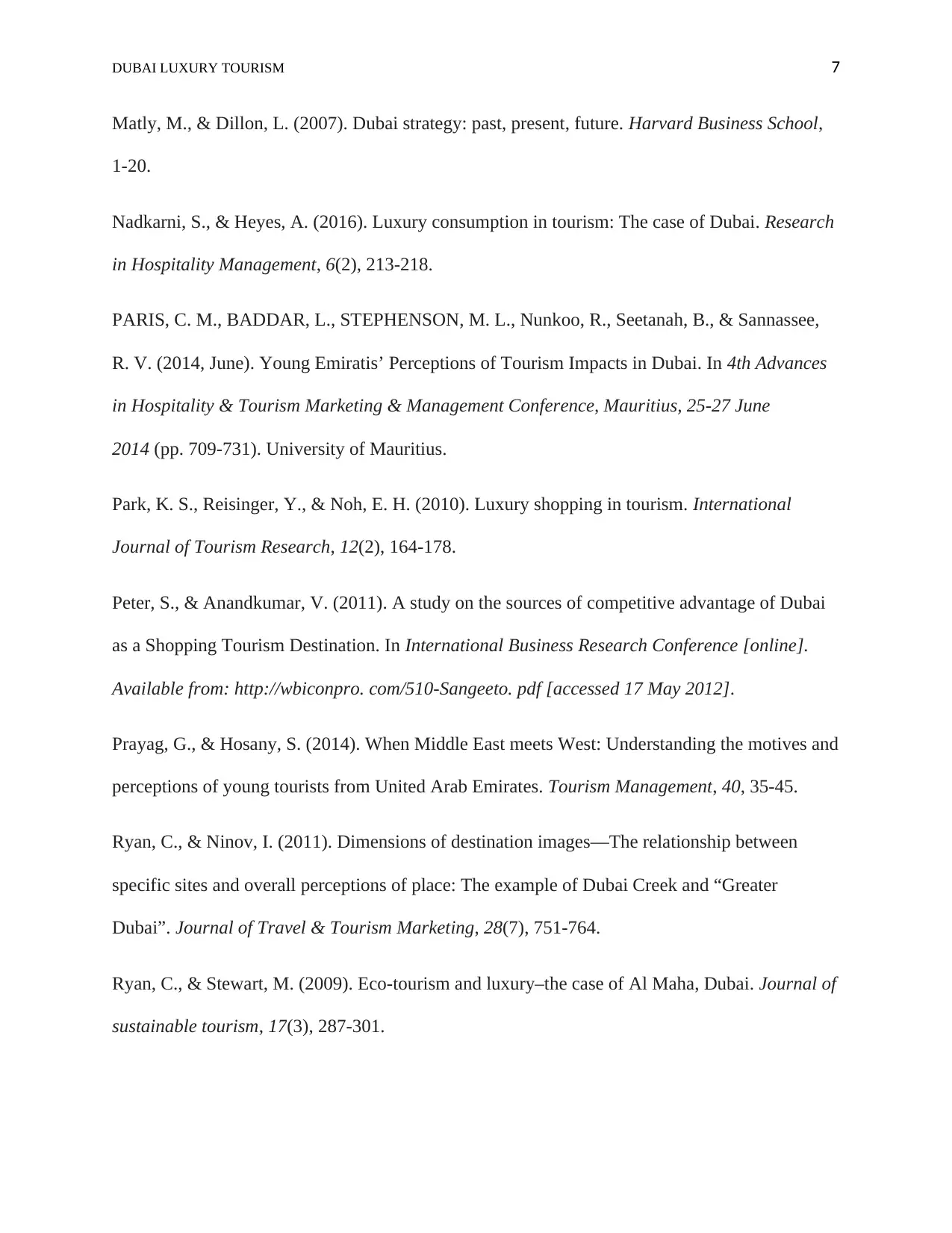
DUBAI LUXURY TOURISM 7
Matly, M., & Dillon, L. (2007). Dubai strategy: past, present, future. Harvard Business School,
1-20.
Nadkarni, S., & Heyes, A. (2016). Luxury consumption in tourism: The case of Dubai. Research
in Hospitality Management, 6(2), 213-218.
PARIS, C. M., BADDAR, L., STEPHENSON, M. L., Nunkoo, R., Seetanah, B., & Sannassee,
R. V. (2014, June). Young Emiratis’ Perceptions of Tourism Impacts in Dubai. In 4th Advances
in Hospitality & Tourism Marketing & Management Conference, Mauritius, 25-27 June
2014 (pp. 709-731). University of Mauritius.
Park, K. S., Reisinger, Y., & Noh, E. H. (2010). Luxury shopping in tourism. International
Journal of Tourism Research, 12(2), 164-178.
Peter, S., & Anandkumar, V. (2011). A study on the sources of competitive advantage of Dubai
as a Shopping Tourism Destination. In International Business Research Conference [online].
Available from: http://wbiconpro. com/510-Sangeeto. pdf [accessed 17 May 2012].
Prayag, G., & Hosany, S. (2014). When Middle East meets West: Understanding the motives and
perceptions of young tourists from United Arab Emirates. Tourism Management, 40, 35-45.
Ryan, C., & Ninov, I. (2011). Dimensions of destination images—The relationship between
specific sites and overall perceptions of place: The example of Dubai Creek and “Greater
Dubai”. Journal of Travel & Tourism Marketing, 28(7), 751-764.
Ryan, C., & Stewart, M. (2009). Eco-tourism and luxury–the case of Al Maha, Dubai. Journal of
sustainable tourism, 17(3), 287-301.
Matly, M., & Dillon, L. (2007). Dubai strategy: past, present, future. Harvard Business School,
1-20.
Nadkarni, S., & Heyes, A. (2016). Luxury consumption in tourism: The case of Dubai. Research
in Hospitality Management, 6(2), 213-218.
PARIS, C. M., BADDAR, L., STEPHENSON, M. L., Nunkoo, R., Seetanah, B., & Sannassee,
R. V. (2014, June). Young Emiratis’ Perceptions of Tourism Impacts in Dubai. In 4th Advances
in Hospitality & Tourism Marketing & Management Conference, Mauritius, 25-27 June
2014 (pp. 709-731). University of Mauritius.
Park, K. S., Reisinger, Y., & Noh, E. H. (2010). Luxury shopping in tourism. International
Journal of Tourism Research, 12(2), 164-178.
Peter, S., & Anandkumar, V. (2011). A study on the sources of competitive advantage of Dubai
as a Shopping Tourism Destination. In International Business Research Conference [online].
Available from: http://wbiconpro. com/510-Sangeeto. pdf [accessed 17 May 2012].
Prayag, G., & Hosany, S. (2014). When Middle East meets West: Understanding the motives and
perceptions of young tourists from United Arab Emirates. Tourism Management, 40, 35-45.
Ryan, C., & Ninov, I. (2011). Dimensions of destination images—The relationship between
specific sites and overall perceptions of place: The example of Dubai Creek and “Greater
Dubai”. Journal of Travel & Tourism Marketing, 28(7), 751-764.
Ryan, C., & Stewart, M. (2009). Eco-tourism and luxury–the case of Al Maha, Dubai. Journal of
sustainable tourism, 17(3), 287-301.
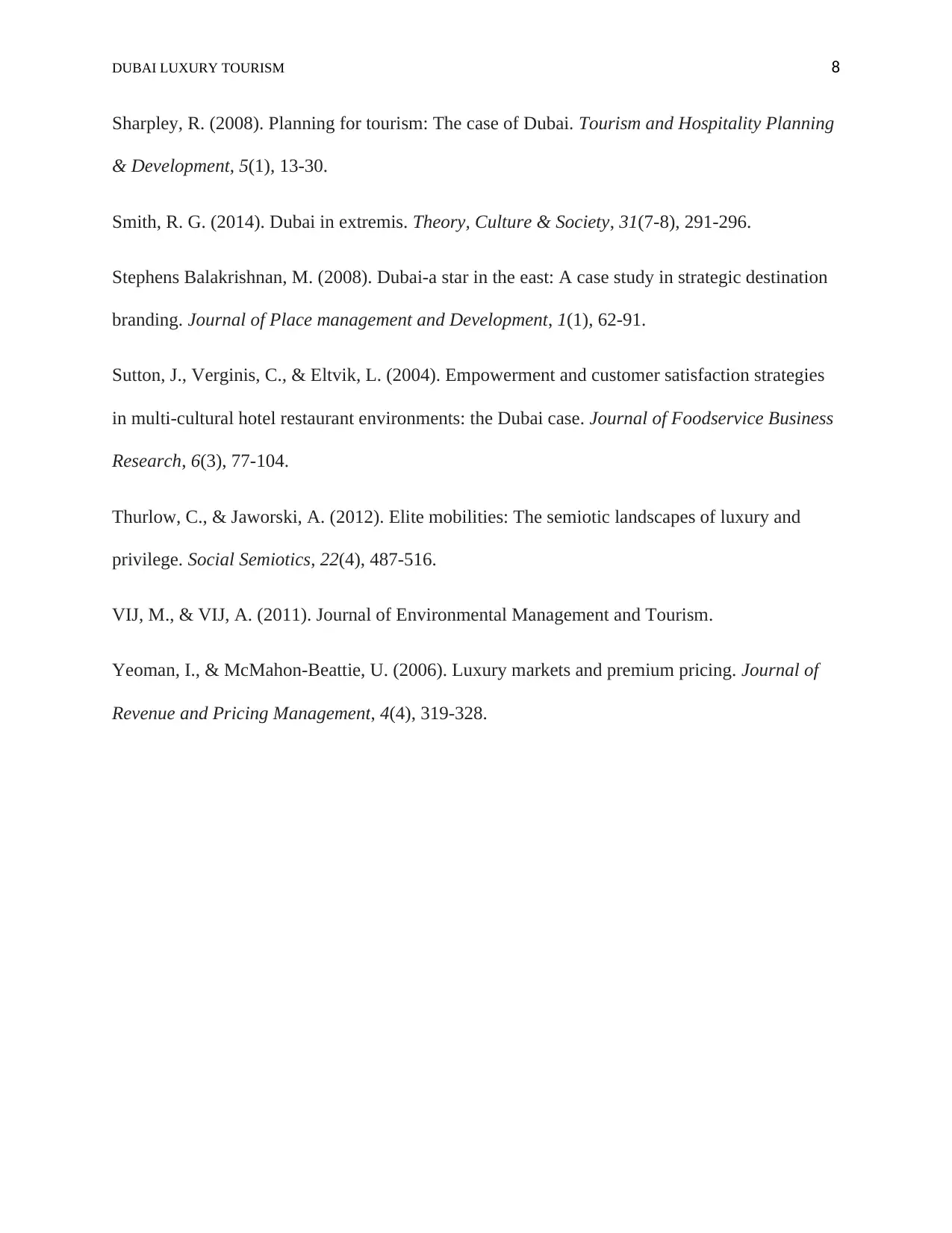
DUBAI LUXURY TOURISM 8
Sharpley, R. (2008). Planning for tourism: The case of Dubai. Tourism and Hospitality Planning
& Development, 5(1), 13-30.
Smith, R. G. (2014). Dubai in extremis. Theory, Culture & Society, 31(7-8), 291-296.
Stephens Balakrishnan, M. (2008). Dubai-a star in the east: A case study in strategic destination
branding. Journal of Place management and Development, 1(1), 62-91.
Sutton, J., Verginis, C., & Eltvik, L. (2004). Empowerment and customer satisfaction strategies
in multi-cultural hotel restaurant environments: the Dubai case. Journal of Foodservice Business
Research, 6(3), 77-104.
Thurlow, C., & Jaworski, A. (2012). Elite mobilities: The semiotic landscapes of luxury and
privilege. Social Semiotics, 22(4), 487-516.
VIJ, M., & VIJ, A. (2011). Journal of Environmental Management and Tourism.
Yeoman, I., & McMahon-Beattie, U. (2006). Luxury markets and premium pricing. Journal of
Revenue and Pricing Management, 4(4), 319-328.
Sharpley, R. (2008). Planning for tourism: The case of Dubai. Tourism and Hospitality Planning
& Development, 5(1), 13-30.
Smith, R. G. (2014). Dubai in extremis. Theory, Culture & Society, 31(7-8), 291-296.
Stephens Balakrishnan, M. (2008). Dubai-a star in the east: A case study in strategic destination
branding. Journal of Place management and Development, 1(1), 62-91.
Sutton, J., Verginis, C., & Eltvik, L. (2004). Empowerment and customer satisfaction strategies
in multi-cultural hotel restaurant environments: the Dubai case. Journal of Foodservice Business
Research, 6(3), 77-104.
Thurlow, C., & Jaworski, A. (2012). Elite mobilities: The semiotic landscapes of luxury and
privilege. Social Semiotics, 22(4), 487-516.
VIJ, M., & VIJ, A. (2011). Journal of Environmental Management and Tourism.
Yeoman, I., & McMahon-Beattie, U. (2006). Luxury markets and premium pricing. Journal of
Revenue and Pricing Management, 4(4), 319-328.
1 out of 9
Your All-in-One AI-Powered Toolkit for Academic Success.
+13062052269
info@desklib.com
Available 24*7 on WhatsApp / Email
![[object Object]](/_next/static/media/star-bottom.7253800d.svg)
Unlock your academic potential
© 2024 | Zucol Services PVT LTD | All rights reserved.